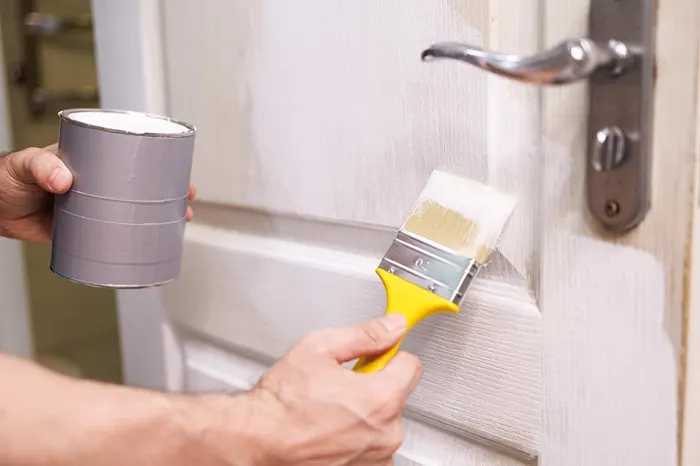I may earn money or products from the companies mentioned in this post. Please click my Disclosure Policy to learn more
Learning how to paint interior doors is a cost-effective way to refresh the look of your home and give it a new lease on life.
Whether you’re a seasoned DIY enthusiast or a homeowner looking to save on professional painting costs, this detailed step-by-step guide will help you achieve a professional finish that transforms your interior doors.
Being in the painting business, I’ve learned from the professionals the ins and outs of painting doors, and I’m excited to share my knowledge with you.

summary of the steps ON HOW TO paint interior doorS:
- Gather Tools and Materials: Collect the necessary tools and materials, including sandpaper, painter’s tape, primer, paint, brushes, rollers, and more.
- Prepare the Door: Remove hardware, clean the surface, sand the door, and protect the surrounding area with drop cloths or plastic sheets.
- Prime the Door: Lay a coat of primer to create a smooth and even base for the paint. Sand the primed surface for a professional finish.
- Choose the Right Paint: Select the appropriate type, finish, and color of paint for your interior door.
- Paint the Door: Apply paint with a brush or roller, starting with cutting in and then covering the flat sections. Apply a second coat once the first one is dry.
- Finishing Touches: Reattach hardware, remove painter’s tape, and allow the paint to fully dry.
These steps, when followed meticulously, will help you paint interior doors to achieve a professional-looking finish.
In this article, we will tackle the following topics:
- Tools and Materials You’ll Need
- Preparing the Door
- Priming the Door
- Choosing the Right Paint
- Painting the Door
- Finishing Touches
- Tips and Tricks for a Professional Finish
HOW TO PAINT INTERIOR DOORS

1. Tools and Materials You’ll Need
Before you start to paint interior doors, gather the necessary tools and materials. Having the right equipment will make the process more efficient and help you achieve a high-quality finish. Here’s what you’ll need:
Materials:
- Interior door(s)
- Sandpaper (120-220 grit)
- Tack cloth
- Painter’s tape
- Drop cloth or plastic sheet
- Paint primer
- Interior paint (latex or oil-based)
- Paint tray and liner
- Paintbrushes (angled and flat)
- Mini paint roller and cover
- Paint thinner (if using oil-based paint)
- Fine-grit sanding sponge (optional)

Tools:
- Screwdriver
- Paint can opener
- Paint can lid with pour spout (for pouring paint into the tray)
- Paint stir stick
- Small step ladder
- Safety goggles and dust mask
- Gloves
- Rags or paper towels
- Putty knife (for removing hardware)
- Fine-tipped paintbrush (for intricate details)
- Optional: paint sprayer
2. Preparing the Door
Proper preparation is the essential to a successful door painting project. Follow these steps to ensure that your interior door is ready for a fresh coat of paint:
Step 1: Remove Hardware
Use a screwdriver to remove the door hardware, such as knobs, hinges, and strike plates. This step allows for a more even and professional paint job. If you cannot remove the door, use painter’s tape to protect the hardware from paint.
Step 2: Clean the Surface
Clean the door, wiping it with a damp cloth to remove dirt, dust, and grease. To ensure proper paint adhesion, follow guidelines.
Step 3: Sand the Door
Use sandpaper (120-220 grit) to lightly sand the door’s surface. This will create a smooth and slightly rough texture, allowing the paint to adhere better. Sand in the direction of the grain if you have a wooden door. For doors with intricate designs, use a fine-grit sanding sponge or sanding block to reach crevices and details.
Step 4: Remove Dust
After sanding, wipe the door with a tack cloth to remove any sanding dust. A clean surface will help the primer and paint adhere better.
Step 5: Protect Surrounding Areas
Cover the surrounding area with a protective drop cloth or plastic sheet to prevent accidental paint splatters or spills on your floor or walls.
Doing some painting yourself? Make sure you pick up this essential painting tool!
3. Priming the Door
Priming is an important step in the painting process. It provides a smooth and consistent base for the paint, enhances adhesion, and ensures the final color looks its best. Follow these steps to prime your interior door:

Step 1: Stir the Primer
Stir the primer thoroughly before use to ensure an even consistency.
Step 2: Apply Painter’s Tape
Use painter’s tape to mask off any areas you want to protect from primer and paint, such as the door frame or glass inserts.
Step 3: Start Priming
Use a paintbrush to cut in along the edges of the door, including any panels or raised sections. Use a mini paint roller to apply primer evenly to flat areas of the door. Roll in the direction of the grain for wooden doors.
Step 4: Allow to Dry
Follow the manufacturer’s instructions for drying time, but typically, primer dries in 1-2 hours. Make sure it’s completely dry before moving on to the next step.
Step 5: Sand the Primed Surface
Lightly sand the primed surface with fine-grit sandpaper to create a smooth and even finish. Wipe and remove any sanding dust with a tack cloth.
Don’t start painting until you have the right tools!
SHOP MUST HAVE PAINTING TOOLS
4. Choosing the Right Paint
Selecting the right paint for your interior door is crucial. Consider the following factors when making your choice:
- Type of Door: Is your door made of wood, MDF, metal, or another material? Different surfaces may require specific types of paint.
- Finish: Go with a finish that suits your style and the room’s purpose. Options include matte, satin, semi-gloss, or high-gloss. For interior doors, a semi-gloss or high-gloss finish is a popular choice because it’s easy to clean and adds a touch of elegance.
- Paint Type: You can use either latex or oil-based paint. Latex paint is water-based, dries faster, and has less odor. Oil-based paint offers a durable finish but requires longer drying times and proper ventilation.
- Color: Select a color that complements your interior décor. You can go for a classic white, a bold color, or even a stain for wood doors.

Step 1: Stir the Paint
Make sure to stir the paint thoroughly to achieve a uniform consistency.. If you’re using oil-based paint, you may need to use paint thinner, so follow the manufacturer’s recommendations.
Step 2: Pour Paint into Tray
Using a paint can lid with a pour spout, transfer some paint into a paint tray. This makes it easier to work with while leaving the rest of the paint can sealed.
Step 3: Cutting In
Begin by painting around the edges of the door with a brush. Apply a thin, consistent, even coat of paint to the door’s panels and raised sections, ensuring clean lines.
5. Paint Interior Doors

Now that your door is primed and you have chosen the right paint, it’s time to apply the paint. Follow these steps for a smooth and professional finish:
Step 1: Apply Paint with a Roller
Use a mini paint roller with a cover appropriate for your chosen paint type and finish. Start by applying a thin and even coat of paint to the flat sections of the door. For wooden doors, roll in the direction of the grain to achieve a smooth finish.
Step 2: Maintain Wet Edges
To avoid lap marks, always maintain wet edges by working in sections and keeping a “wet” edge where you’re applying new paint. This ensures a seamless finish.
Step 3: Apply a Second Coat
Once the first coat is dry to the touch (typically 2-4 hours), apply a second coat using the same technique. A second coat will give your door a more even and opaque finish.
Step 4: Dry Time
Allow the door to dry for the time specified by the paint manufacturer. Drying times may vary depending on the type and brand of paint you’re using.
6. Finishing Touches
After painting the door, you’ll want to reattach any hardware and put the finishing touches on your project. Here’s what to do:
Step 1: Reattach Hardware
Once the paint is fully dry ( make sure it 100% dry), reattach the door hardware, including knobs, hinges, and strike plates.
Step 2: Remove Painter’s Tape
Carefully remove any painter’s tape from the door frame or other protected areas. This should be done once the paint is dry but not fully cured to ensure clean lines.
Tips and Tricks to Paint Interior Doors for a Professional Finish
Achieving a professional finish requires attention to detail and a few tricks of the trade. Here are some additional tips to help you get the best results:
- Work in a Clean and Dust-Free Environment: Keep your workspace clean and dust-free to prevent debris from landing on your freshly painted door.
- Use High-Quality Brushes and Rollers: Invest in high-quality brushes and rollers for a smoother finish and better paint coverage.
- Apply Multiple Thin Coats: It’s better to apply numerous light coats of paint rather than one thick coat. Thin coats are less likely to drip or sag.
- Sand Between Coats: Lightly sand the door between coats to remove any imperfections and create a smooth surface.
- Use an Edging Tool: An edging tool will help you create clean and precise lines, especially when cutting in around edges and panels.
- Consider a Paint Sprayer: If you’re painting multiple doors or large surfaces, a paint sprayer can save you time and provide a smooth finish.
- Ventilate the Area: Proper ventilation is essential, especially when using oil-based paints. Use fans and open windows to ensure good airflow.
- Don’t Rush: Take your time, especially when cutting in and applying the first coat. Rushing can lead to uneven results.
DON’T FORGET YOUR TOOLS AND ACCESSORIES!
Make your life easier by using the painting tools the pros use!
This paintbrush will up your painting game!
FINAL THOUGHTS – TIPS TO PAINT INTERIOR DOORS
Painting interior doors is a satisfying and budget-friendly way to refresh the look of your home. By observing the steps outlined in this guide, you can achieve a professional finish that transforms your interior doors.
Remember to invest in high-quality tools and materials, properly prepare the door, select the right paint, and apply it with care. With patience and attention to detail, your doors will look as good as if they were painted by a seasoned pro.
Happy painting, and enjoy your newly refreshed interior doors!
RECENT ARTICLES:
- How to Paint Kitchen Cabinets
- Benjamin Moore Classic Gray Color Review
- SW Granite Peak
- Sherwin Williams Creamy Review
- Benjamin Moore Carolina Gull
- Farmhouse Cabinet Colors
- Sherwin Williams Dried Thyme Review
- Vintage Modern Living Room Designs

I’m Cate. As a seasoned paint color consultant and former proprietor of the highly regarded painting company WOW 1 Day Painting in Bergen County, my journey in the world of design and home improvement has been a colorful one, quite literally. Nestled in the scenic landscapes of Northern New Jersey, I’ve cultivated a passion for transforming spaces through the power of paint, furniture restoration, and thoughtful home decor.



